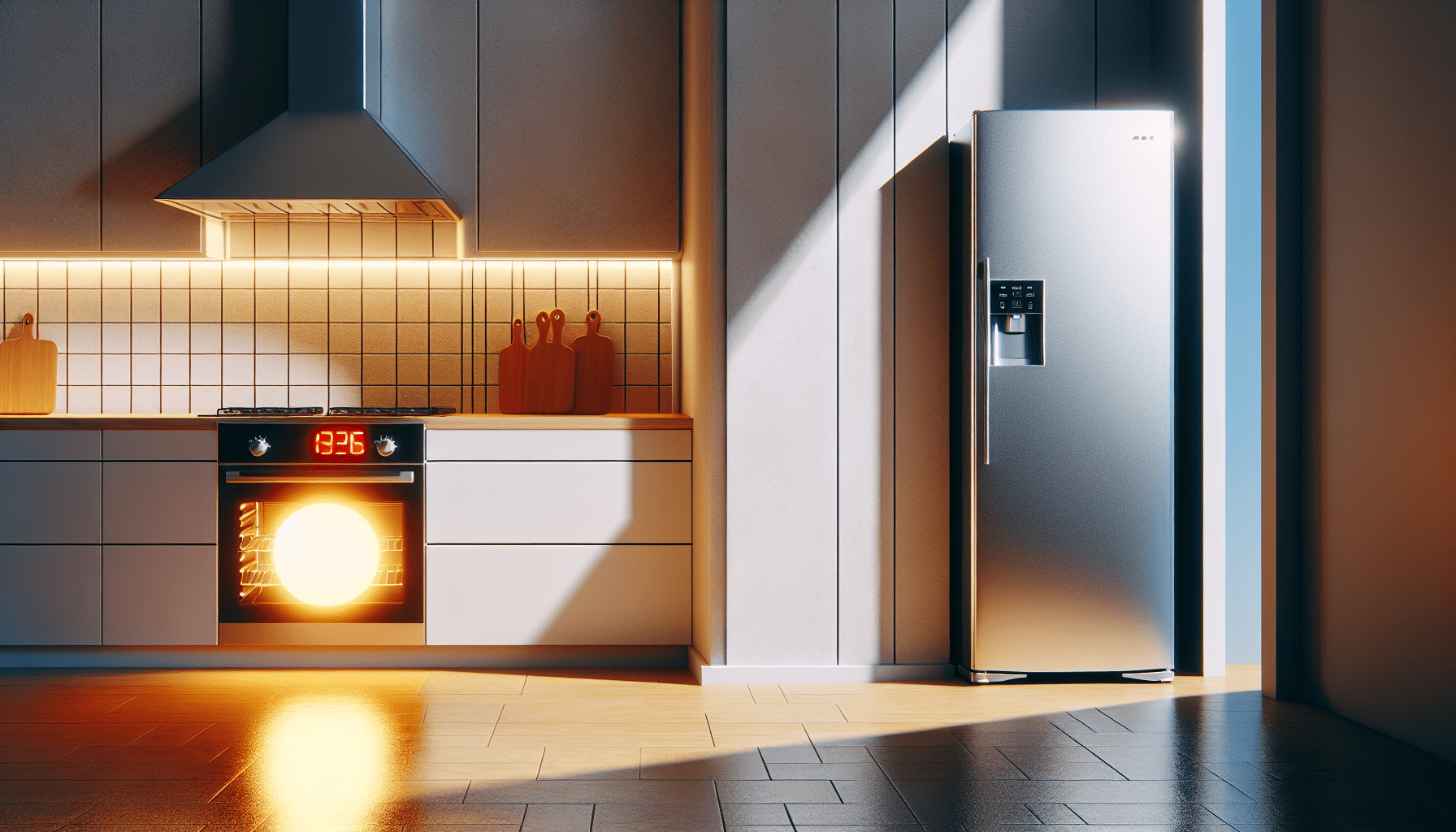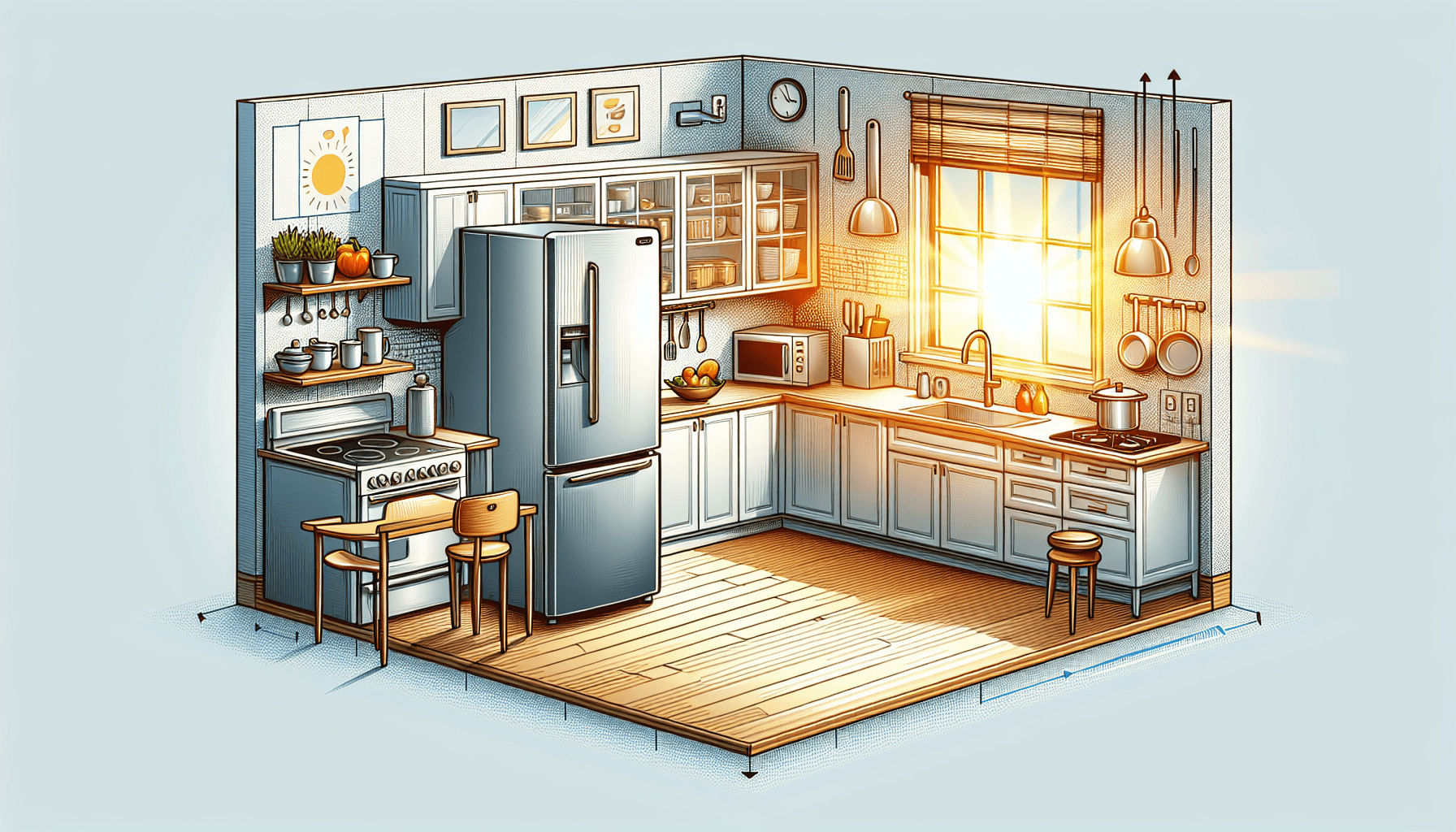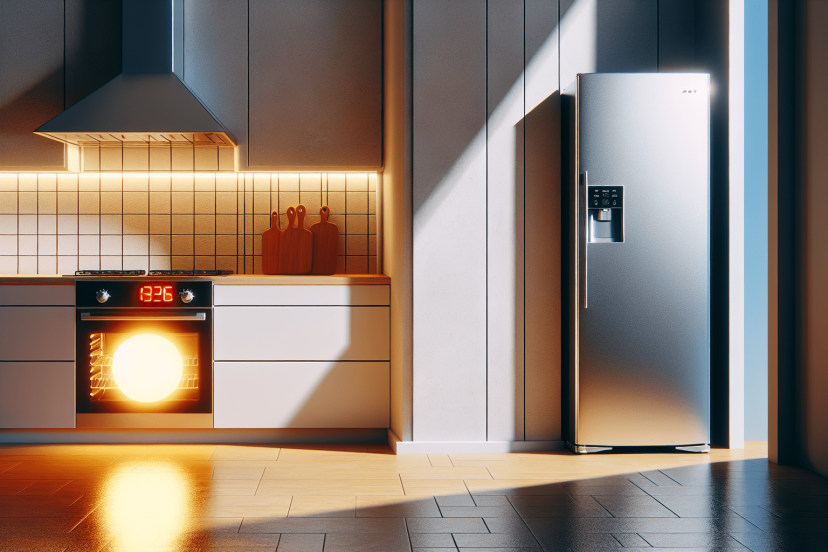Where Should You Not Put A Refrigerator In The Kitchen?
If you’ve ever wondered about the ideal placement for your refrigerator in the kitchen, look no further. In this article, we will explore the areas in the kitchen where you should avoid placing a refrigerator. By understanding these potential pitfalls, you can ensure that you make the most of your kitchen space while also optimizing the functionality and efficiency of your refrigerator. So, let’s dive in and discover the spots you should steer clear of when it comes to refrigerator placement in the kitchen.

Next to the stove
Heat can affect the refrigerator’s efficiency
When considering the placement of your refrigerator in the kitchen, it’s important to avoid placing it next to the stove. The heat generated by the stove can have a significant impact on the efficiency of your refrigerator. The heat from the stove can seep into the refrigerator, causing it to work harder to maintain the desired temperature. This can result in increased energy consumption and potentially lead to a shorter lifespan for your refrigerator.
Heat can cause the refrigerator to work harder
Another reason to keep your refrigerator away from the stove is that the heat can cause the refrigerator to work harder than necessary. When the stove is in close proximity to the refrigerator, the heat radiating from the stove can cause the temperature inside the refrigerator to rise. As a result, the compressor in the refrigerator has to work harder to bring the temperature back down to the desired level. This constant strain on the compressor can lead to increased wear and tear on the refrigerator’s components, reducing its overall efficiency and longevity.
Proximity to the stove can cause temperature fluctuations
Placing your refrigerator next to the stove can also result in temperature fluctuations within the refrigerator. The heat from the stove can cause the surrounding air temperature to rise, which can then influence the temperature inside the refrigerator. This can lead to your food and beverages being exposed to inconsistent temperatures, potentially impacting their quality and shelf life. To ensure optimal cooling and food safety, it is best to place the refrigerator away from any heat sources such as the stove.
Direct sunlight
Sunlight can heat up the refrigerator
Direct sunlight can also have a negative impact on your refrigerator’s performance if it is placed in an area where it is exposed to sunlight for extended periods. Sunlight can heat up the exterior surface of the refrigerator, which in turn can increase the temperature inside. When the refrigerator is consistently exposed to sunlight, it has to work harder to maintain the desired temperature, leading to increased energy consumption.
Excessive heat can damage the refrigerator’s components
Apart from affecting the temperature inside the refrigerator, excessive heat from direct sunlight can also cause damage to the refrigerator’s components. The increased external temperature can put added strain on the internal mechanisms of the refrigerator, potentially leading to malfunctions or premature failure. This can result in costly repairs or the need for a replacement refrigerator.
Sunlight can affect the performance of the refrigerator
Sunlight can also have a direct impact on the performance of your refrigerator. When the refrigerator is exposed to sunlight, it can cause uneven cooling and temperature fluctuations. The heat from the sunlight can create hotspots inside the refrigerator, affecting the overall distribution of cold air. This can lead to certain areas of the refrigerator being warmer than others, compromising the freshness and safety of your food.
Near a dishwasher
High temperatures from the dishwasher can affect the refrigerator
Placing your refrigerator near a dishwasher may seem convenient, but it can have negative consequences on its performance. One of the main issues is the high temperatures that are generated by the dishwasher during its operation. The heat from the dishwasher can radiate to the surrounding area, including the refrigerator. This additional heat can cause the refrigerator to work harder, resulting in increased energy consumption and potential damage to its components.
Heat can impact the refrigerator’s ability to cool
The heat generated by the dishwasher can also impact the refrigerator’s ability to cool effectively. The close proximity of the dishwasher can increase the temperature around the refrigerator, making it more challenging for the refrigerator to maintain the desired cold temperature. This can lead to compromised cooling performance and potentially spoilage of food items.
Proximity to a dishwasher can lead to energy inefficiency
When your refrigerator is located near a dishwasher, it can lead to energy inefficiency. The extra heat from the dishwasher can cause the refrigerator to work harder to maintain the desired temperature, resulting in increased energy consumption. Over time, this can lead to higher energy bills and a less environmentally friendly kitchen setup. To promote energy efficiency, it is advisable to keep the refrigerator away from any high-heat appliances like dishwashers.
Close to an oven
Oven heat can affect the refrigerator’s cooling process
Placing your refrigerator close to an oven can have a detrimental effect on its cooling process. The heat generated by the oven can infiltrate the refrigerator, creating an environment that is warmer than desired. This can make it harder for the refrigerator to maintain the correct temperature and can lead to fluctuating temperatures inside. As a result, food items may not stay as fresh as they should, potentially leading to spoilage.
Temperature fluctuations can occur near an oven
The proximity of a refrigerator to an oven can cause temperature fluctuations within the refrigerator. The heat emanating from the oven can create hotspots near the refrigerator, leading to inconsistent cooling. These temperature fluctuations can be detrimental to perishable food items, compromising their quality and safety. To ensure optimal refrigeration, it is best to place the refrigerator away from any heat sources, such as ovens.
Heat from the oven can cause the refrigerator to overwork
Placing your refrigerator close to an oven can cause it to overwork. The heat from the oven can infiltrate the refrigerator, forcing its internal components to work harder to maintain the desired temperature. This constant strain on the refrigerator can lead to increased wear and tear, reducing its overall efficiency and potentially shortening its lifespan. It is important to create a suitable distance between the refrigerator and the oven to avoid unnecessary strain on the refrigerator’s components.

In cramped spaces
Limited airflow can reduce the refrigerator’s efficiency
When considering where to place your refrigerator in the kitchen, it is crucial to avoid cramped spaces. In such areas, limited airflow around the refrigerator can hinder its efficiency. Proper airflow is necessary for the refrigerator to expel heat and maintain its cooling capabilities. Without adequate airflow, the refrigerator may struggle to cool properly and consume more energy in the process.
Build-up of heat can affect the refrigerator’s performance
In cramped spaces, heat generated by the refrigerator can become trapped, leading to a build-up of heat in the immediate vicinity. This heat build-up can affect the performance of the refrigerator, making it harder for it to maintain the desired temperature. It can also cause the refrigerator’s components to work harder, potentially leading to increased wear and tear.
Insufficient space can lead to difficulty in accessing and cleaning the refrigerator
Placing a refrigerator in a cramped space can also create difficulties in terms of accessibility and cleaning. With limited space, it may be challenging to open the refrigerator doors fully or remove refrigerator shelves and drawers for cleaning purposes. This can make cleaning and maintenance tasks more time-consuming and less convenient. It is important to provide adequate space around the refrigerator to ensure easy access and proper maintenance.
In a corner
Corner placement can obstruct airflow
One common mistake when positioning a refrigerator in the kitchen is placing it in a corner. Corner placement can obstruct airflow, which is essential for the refrigerator’s proper functioning. Effective airflow allows the refrigerator to expel heat and maintain a consistent internal temperature. When placed in a corner, the refrigerator may struggle to expel heat efficiently, leading to reduced cooling capabilities.
Restricted airflow can impact the refrigerator’s cooling ability
When a refrigerator is positioned in a corner, restricted airflow can negatively impact its cooling ability. The lack of adequate airflow can lead to uneven cooling within the refrigerator, potentially resulting in inconsistent temperature distribution. This can compromise the freshness of food items and contribute to a less efficient cooling process.
Difficulties in cleaning and maintenance may arise
placing a refrigerator in a corner can also present challenges when it comes to cleaning and maintenance. The restricted space can make it difficult to access the backside of the refrigerator for cleaning and inspection purposes. This can lead to the accumulation of dust and debris, potentially affecting the refrigerator’s performance over time. To ensure proper maintenance and cleanliness, it is advisable to avoid corner placements for your refrigerator.
Next to a wall
Inadequate airflow can hinder the refrigerator’s performance
Positioning your refrigerator next to a wall can hinder its performance due to inadequate airflow. When the refrigerator is placed too close to a wall, it restricts the airflow around the refrigerator, making it harder for the heat to dissipate. As a result, the refrigerator may struggle to cool efficiently, leading to increased energy consumption and potential issues with food storage.
Heat accumulation near the wall can affect efficiency
When a refrigerator is placed next to a wall, heat can accumulate in the area between the refrigerator and the wall. This heat accumulation can impact the refrigerator’s efficiency, making it harder for it to maintain the desired temperature. Additionally, the increased heat in the surrounding area can put additional strain on the refrigerator’s components, potentially leading to decreased performance and a shorter lifespan.
Accessing the refrigerator’s backside for maintenance can be challenging
Another issue that arises when a refrigerator is placed next to a wall is the difficulty in accessing the backside of the refrigerator for maintenance purposes. Regular cleaning and maintenance of the refrigerator’s backside is important to ensure optimal performance and longevity. However, when the refrigerator is placed too close to a wall, it becomes challenging to reach the backside, hindering the maintenance process.
Against a cabinet
Cabinet proximity can lead to overheating
Placing a refrigerator against a cabinet is another positioning mistake to avoid. The proximity to the cabinet can lead to overheating of the refrigerator. When the refrigerator is sandwiched between the cabinet and the wall, it restricts airflow and hampers the dissipation of heat. This can cause the refrigerator to overheat, leading to decreased efficiency and potential damage to its components.
Restricted airflow can reduce the refrigerator’s cooling capabilities
When a refrigerator is positioned against a cabinet, the restricted airflow can have a direct impact on its cooling capabilities. Insufficient airflow inhibits the refrigerator’s ability to expel heat and maintain the desired internal temperature. As a result, the cooling process may be compromised, leading to inconsistent temperatures inside and potentially jeopardizing the quality and safety of stored food.
Cleaning and maintenance of the refrigerator’s sides can become difficult
Placing a refrigerator against a cabinet can also make cleaning and maintenance tasks more challenging. The limited space between the refrigerator and the cabinet may hinder your ability to clean the sides of the refrigerator effectively. Additionally, accessing the sides for maintenance purposes, such as replacing filters or inspecting components, can be cumbersome. It is advisable to provide sufficient space around the refrigerator to ensure easy cleaning and maintenance.
Under a counter
Lack of ventilation space can cause the refrigerator to overheat
Under-counter refrigerators are a popular choice for compact kitchen designs, but they require careful consideration of their placement. Placing a refrigerator under a counter without adequate ventilation space can cause it to overheat. Under-counter refrigerators rely on ventilation to expel heat and maintain proper cooling. Without sufficient ventilation space, the refrigerator can become trapped in its own heat, leading to decreased cooling efficiency and potential damage.
Insufficient clearance can hinder the refrigerator’s cooling process
Inadequate clearance space above an under-counter refrigerator can hinder its cooling process. Under-counter refrigerators rely on a certain amount of space above them to allow for proper airflow. When placed in a tight space with limited clearance, the refrigerator may struggle to draw in fresh air, leading to inefficient cooling and potential temperature inconsistencies.
Limited visibility and accessibility can lead to inconvenience
Placing a refrigerator under a counter can also lead to limited visibility and accessibility. Retrieving items from the refrigerator may become more challenging due to the lower positioning. Additionally, the limited space above the refrigerator can make it difficult to monitor and access the controls and displays. It is important to consider the convenience and ease of use when deciding to place a refrigerator under a counter.
In an area prone to moisture
Excessive moisture can damage the refrigerator’s components
Placing a refrigerator in an area prone to moisture, such as near a sink or dishwasher, can result in damage to its components. Excessive moisture in the air can cause condensation to form on the refrigerator’s exterior and interior surfaces. This moisture can seep into the refrigerator’s electrical components and insulation, potentially leading to rust, corrosion, and electrical malfunctions.
Moisture can lead to mold growth and odors in the refrigerator
In addition to damage to the refrigerator’s components, moisture can also contribute to the growth of mold and the development of unpleasant odors. Moisture provides an ideal environment for mold growth, and if it enters the refrigerator, it can contaminate stored food items. Mold growth and odors can compromise the freshness and safety of food, requiring more frequent cleaning and potentially necessitating the disposal of affected items.
High humidity can affect the efficiency and lifespan of the refrigerator
High humidity in the surrounding environment can also affect the efficiency and lifespan of the refrigerator. High humidity levels make it harder for the refrigerator to expel heat and maintain the desired internal temperature. As a result, the refrigerator may have to work harder and consume more energy to cool effectively. This prolonged strain can shorten the lifespan of the refrigerator and increase energy costs. To ensure optimal performance and longevity, it is best to keep the refrigerator away from areas prone to excessive moisture.
In conclusion, the placement of your refrigerator in the kitchen plays a crucial role in its efficiency and performance. Avoiding certain areas such as next to the stove, in direct sunlight, near a dishwasher or oven, in cramped spaces, in corners, next to walls or cabinets, under counters, and in areas prone to moisture can help ensure your refrigerator operates optimally and has a longer lifespan. By considering these factors and following the guidelines provided, you can create an environment that maximizes the functionality and reliability of your refrigerator.




